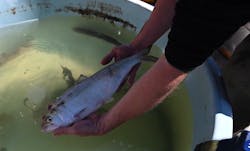Whooshh! Santee Cooper Sends Fish Flying Over Santee Spillway
For more than 80 years, the Santee Spillway has helped control water flow between Lake Marion and the Santee River, but it has also blocked the migration of fish swimming upstream to spawn. Now, a new public-private research project is giving American shad and blueback herring a “jump” over the Spillway and onto spawning grounds.
The Electric Power Research Institute (EPRI), Santee Cooper and Whooshh Innovations are conducting a field study on the ability of the Whooshh Passage Portal (WPP) to transport these fish species upstream and over the Santee Spillway into Lake Marion.
“During this field study, American shad have traveled through the Whooshh system. This is a significant milestone, and we are encouraged with the success we’ve seen so far,” said Jane Campbell, senior director of environmental and water systems at Santee Cooper. “We will continue to work with other environmental, research and utility organizations to see whether the system is an effective and economical solution to fish passage in the Santee Cooper Lakes.”
The study is evaluating WPP’s innovative transport technology for shad and herring with respect to passage efficiency, fish health and migration success. The study, which is funded through EPRI by Santee Cooper, FirstLight Power, New Brunswick Power and New York Power Authority, began on Feb. 21, 2022, and is scheduled to conclude at the end this month.
The field study also addresses an anticipated requirement related to fish passage for the Santee Cooper Project’s Federal Energy Regulatory Commission (FERC) relicensing. Currently, fish passage takes place at two locations on the Santee Cooper Lakes – the Pinopolis Lock and St. Stephen Hydro Plant.
“Numerous hydropower operators on the East Coast are working toward FERC relicensing, and providing fish passage facilities at hydropower dams is a top priority for federal and state agencies due to declining stocks and ongoing restoration efforts,” said Brandon Delis, director for environmental sciences and technology at EPRI. “This study is an important step toward finding fish passage solutions at the Santee Spillway and at other locations.”
The Whooshh Passage Portal moves fish through a tube using only water mist and differential pressure to glide fish from the downstream entrance to upstream exit. The field study will help provide additional data needed to assess the effectiveness of the WPP entry system and to confirm the health of the fish that move through it.
“Much like salmon, spawning adult shad play a vital ecological role and are capable of migrating hundreds of miles upstream,” said Whooshh Innovations CEO Vincent Bryan. “This is an exciting time for the rehabilitation and restoration of native fish populations, and we are thrilled to be collaborating on this study and taking another step toward a more fish-friendly hydropower future.”
In addition to shad, adult herring are important to South Carolina’s ecosystem. Herring migrate between freshwater and saltwater and can travel up to 100 miles to spawn.
About the Author
T&D World Staff
Content Team
Nikki Chandler
Group Editorial Director, Energy
[email protected]
Jeff Postelwait
Managing Editor
[email protected]
Christina Marsh
Senior Editor
[email protected]
Ryan Baker
Associate Editor
[email protected]
Amy Fischbach
Electric Utility Operations
[email protected]
Rich Maxwell
Community Editor
[email protected]
Gene Wolf
Technical Editor
[email protected]
